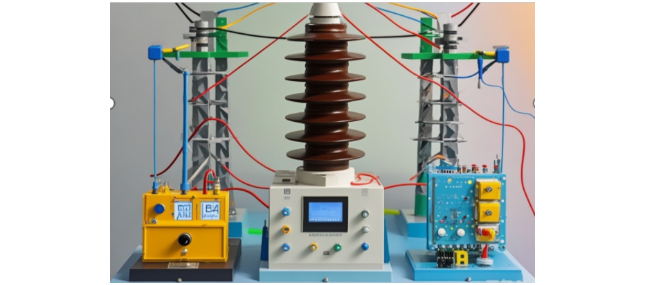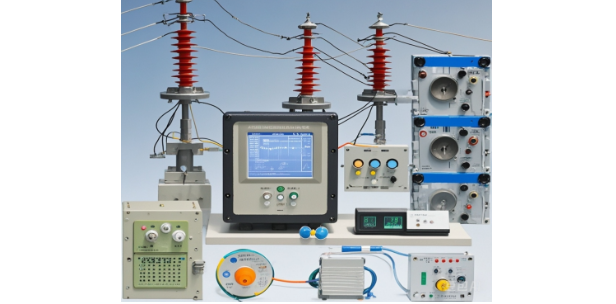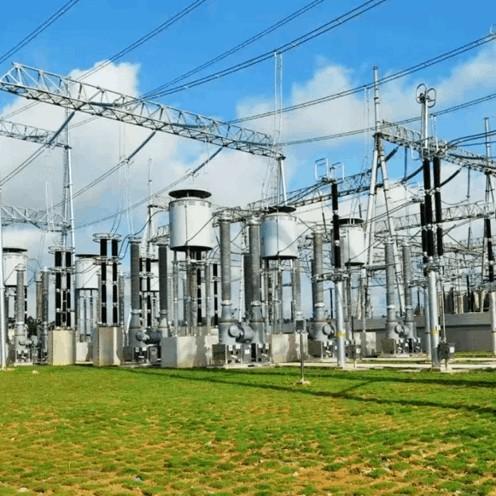1 Importansya sa Mga Monitor Online sa Surge Arrester
1.1 Pataas ang Seguridad sa Sistema sa Kuryente, Bawasan ang Pagkasira Tungod sa Lightning
Durante sa pag-atake sa lightning, ang mga surge arrester naglilisod sa pag-discharge sa overvoltage. Ang mga monitor online sigurado ang estabilidad sa arrester, detekta ang potensyal nga mga sayop sa real-time, ug trigger og alarm para sa maong panahon nga interbensyon—efektibong gipababa ang pagkasira nga gihatag sa lightning sa mga kagamitan ug sistema sa kuryente, ug naghimo og stable nga operasyon.
1.2 Real-Time Monitoring sa Status, Pataas ang Efisiyensiya sa Maintenance
Ang mga monitor nagsunod sa key parameters (e.g., leakage current) sa tuloy-tuloy. Sa pag-identipikar sa mga unang sayop ug pagwasay sa secondary accidents, sila optimisa ang scheduling sa maintenance, minimo ang unnecessary outages, ug sigurado ang reliable nga supply sa kuryente—kritisikal para sa seguridad ug efisiyensiya sa sistema.
2 Prinsipyos sa Mga Test Device sa Online Monitor
2.1 Signal Acquisition
Ang mga monitor nakolekta og signals pinaagi sa mga koneksyon sa arrester. Sa normal nga operasyon, ang mga arrester remain stable; duranteng overvoltage events (lightning/switching), sila activate aron mag-discharge og energy. Ang mga monitor gamit ang sensors aron makuha ang duha ka key parameters:
Leakage Current: Ang mga current transformers convert ang leakage current isip measurable nga electrical signals;
Operation Count: Ang mga discharge events detected pinaagi sa specific nga signals generated duranteng activation sa arrester.
2.2 Signal Processing & Analysis
Ang nakolektang signals ginaproseso pinaagi sa tulo ka key modules:
Amplifier: Boosts ang weak signals para sa subsequent processing;
Filter: Removes ang noise/interference, improving signal quality;
ADC (Analog-to-Digital Converter): Converts analog signals to digital format para sa precise analysis.
Ang processed digital signals ginanalisa pinaagi sa microprocessors/chips, focusing on:
Insulation Assessment: Calculates ang magnitude/phase sa leakage current aron i-evaluate ang performance sa insulation. Excessive leakage indicates degraded insulation ug rising fault risks;
Operation Statistics: Tracks ang frequency sa activation, reflecting lightning activity levels o arrester degradation (over-frequent operations may signal intense lightning or performance decline).
3 Kasinatian sa Traditional Test Devices
3.1 Low Testing Precision
Ang analog-based signal processing vulnerable sa interference (e.g., noise masking small leakage current changes). Ang accuracy sa sensor ug signal conditioning circuits further impact precision, reducing data reliability.
3.2 Limited Functionality
Ang traditional devices test lang basic parameters (leakage current, operation count) pero lack advanced features (fault diagnosis, data analytics), making it hard to detect hidden risks comprehensively.
3.3 Complex Operations
Ang testing requires cumbersome wiring (e.g., sensor installation, signal connections) ug unfriendly interfaces, increasing user error risks ug operational difficulty.
3.4 Poor Reliability
Ang mechanical components (e.g., switches prone to wear, poor contact) ug analog circuits (sensitive to temperature/humidity) cause frequent failures. Ang maintenance demands specialized skills, raising costs ug complexity.
Ang traditional device structures ug defects mahimong visualize sa Figure 1.

4 Improvement Measures for Surge Arrester Online Monitor Test Devices
4.1 Adopt Digital Signal Processing Technology
Ang digital signal processing technology boasts advantages such as strong anti-interference capability, high precision, ug good stability. Applying it to the surge arrester online monitor test device can effectively enhance test accuracy ug stability. For example, digital filtering technology can accurately remove noise interference in signals, significantly optimizing signal quality; digital signal processing algorithms can precisely calculate key parameters like leakage current ug operation times, further improving test precision.
4.2 Add Functional Modules
To meet users' demands for advanced functions of surge arrester online monitor test devices, the improved device adds functional modules such as fault diagnosis ug data analysis. By analyzing parameters like leakage current ug operation times, potential fault hazards of surge arresters can be accurately identified; statistical analysis of historical data helps clearly grasp the operation trend of arresters, providing reliable basis for preventive maintenance.
4.3 Optimize the Operation Interface
To improve the convenience of operating the surge arrester online monitor test device, the operation interface is optimized. For instance, touch-screen technology is introduced, allowing users to complete operations and parameter settings directly via touch; a graphical interface enables users to intuitively understand test results and device status, enhancing the operation experience.
4.4 Enhance Reliability
4.4.1 Modular Design
Adopt a modular design approach, dividing the test device into multiple independent modules. Each module can work separately, greatly reducing maintenance and repair difficulties and improving the device's maintainability.
4.4.2 High-Quality Components and Materials
Select high-quality components and materials to ensure the stability and reliability of the test device at the hardware level, reducing issues caused by hardware failures.
4.4.3 Strict Quality Control
Implement strict quality control and testing procedures to comprehensively inspect the performance and quality of the test device, ensuring it meets design and usage requirements and laying a solid foundation for stable device operation.
The schematic diagram of the improved surge arrester online monitor test device is shown in Figure 2.

5 Case Analysis
5.1 Case Introduction
A set of surge arresters in a substation was selected as the test object. The improved test device was used to conduct comprehensive tests, including measuring parameters such as leakage current, operation count, and resistive current, as well as verifying functions like fault diagnosis and data analysis.
5.2 Test Process and Results
5.2.1 Leakage Current Test
The improved device measured the arrester's leakage current, which remained stable within the normal range with no significant deviation from historical data. This indicates good insulation performance, with no abnormal increase in leakage current.
5.2.2 Operation Count Test
By simulating arrester operations, the improved device accurately recorded operation counts, matching actual actions. This confirms the device's capability to provide reliable data for operation and maintenance.
5.2.3 Resistive Current Test
Resistive current measurements (via the improved device) stayed within normal ranges, consistent with historical data. This reflects normal resistive components, with no signs of aging or damage.
5.2.4 Fault Diagnosis Verification
By simulating faults (e.g., sensor malfunctions, signal conditioning circuit issues), the improved device accurately detected fault points and provided clear alerts. This verifies the reliability of its fault diagnosis function for timely defect identification.
5.2.5 Data Analysis Verification
Analyzing historical arrester data, the improved device generated trend charts for parameters (leakage current, operation count) and detailed reports. This demonstrates robust data analysis capabilities, supporting scientific operation and maintenance decisions.
5.3 Result Analysis
The improved test device features high precision, comprehensive functions, user-friendly operation, and strong reliability—fully meeting testing requirements for surge arrester online monitors.
Its fault diagnosis and data analysis capabilities enable proactive identification of potential issues, enhancing equipment reliability and safety. Overall, the device improves testing efficiency and accuracy, safeguarding the stable operation of power systems.
6 Conclusion
As power systems evolve, demands for accuracy and reliability of surge arrester online monitors continue to rise. This paper introduces improvements to test devices—optimizing signal acquisition, processing, control, display, and power modules—to enhance stability and precision.
Field tests validate the device's effectiveness, providing a reliable basis for quality inspection of online arrester monitors. Future efforts should focus on advancing power equipment detection technologies, continuously refining test devices to further ensure the safe and stable operation of power systems.
























